Picture |
Object
name
#NORAD |
Description |
Launch
Date |
Weight |

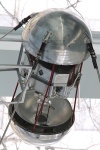

|
Sputnik
1
Sputnik I
#00002
1957-001B
1957
Alpha 2 |
 This
first man made satellite in space was launched by USSR
into an elliptical orbit with an inclination of 65 degrees,
a perigee of 238 km and an apogee of 947 km. Sputnik
1 needed 96,2 minutes to circulate the Earth. This
first man made satellite in space was launched by USSR
into an elliptical orbit with an inclination of 65 degrees,
a perigee of 238 km and an apogee of 947 km. Sputnik
1 needed 96,2 minutes to circulate the Earth.  The
spherical satellite had a diameter of 58cm and carried
2 radio beacons transmitting on 20.005 MHz and 40.010
MHz. The batteries powering the transmitters had a lifetime
of 21 days. Sputnik 1 reentered the Earth's atmosphere
after 92 days and decayed on January 4th
1958. Recording kindly provided by Alois DL3PD (SK). The
spherical satellite had a diameter of 58cm and carried
2 radio beacons transmitting on 20.005 MHz and 40.010
MHz. The batteries powering the transmitters had a lifetime
of 21 days. Sputnik 1 reentered the Earth's atmosphere
after 92 days and decayed on January 4th
1958. Recording kindly provided by Alois DL3PD (SK).
|
Oct
4th 1957 |
83,6
kg |
 On October On October
 6th
1957 around 20:00 UTC Sputnik 1 was received on 20 MHz
by Bayrische Volkssternwarte in Munich. The recording
was kindly provided by Tobias Lindemann and Josef Huber. 6th
1957 around 20:00 UTC Sputnik 1 was received on 20 MHz
by Bayrische Volkssternwarte in Munich. The recording
was kindly provided by Tobias Lindemann and Josef Huber.
|
 This
audio file was recorded by Roy This
audio file was recorded by Roy  W0SL
in Dallas, Texas on October 7th,
1957 at 0457UTC using a military surplus AN/FRR3A HF
RTTY receiver tuned to 20.007 MHz. Thanks Roy for providing
this recording. W0SL
in Dallas, Texas on October 7th,
1957 at 0457UTC using a military surplus AN/FRR3A HF
RTTY receiver tuned to 20.007 MHz. Thanks Roy for providing
this recording.
|
 This
recording is from an unknown German ham-radio amateur.
It was filtered and provided by Don P. Mitchell. This
recording is from an unknown German ham-radio amateur.
It was filtered and provided by Don P. Mitchell.
|
 An unknown
British SWL is commenting the reception of Sputnik 1
on October 11th 1957 at 10:58pm.
The original source of this recording is unknown. The
recording was kindly provided by Bill KA8VIT. (Please
note that this recording is 5MB large). An unknown
British SWL is commenting the reception of Sputnik 1
on October 11th 1957 at 10:58pm.
The original source of this recording is unknown. The
recording was kindly provided by Bill KA8VIT. (Please
note that this recording is 5MB large).
|
 Enclosed
recording of Sputnik 1 is from a radio station in Milwaukee.
The recording is from vinyl no. 1 which was included
in the Italian Enciclopaedia Luomo e lo spazio (The
man and the space) issued 1965 by Fratelli Fabbri. Digitized
and kindly provided by Federico Manzini. Enclosed
recording of Sputnik 1 is from a radio station in Milwaukee.
The recording is from vinyl no. 1 which was included
in the Italian Enciclopaedia Luomo e lo spazio (The
man and the space) issued 1965 by Fratelli Fabbri. Digitized
and kindly provided by Federico Manzini.
|
 This Audio
file was published by NASA and provides various analysis
of the Sputnik 1 radio emissions conducted by Caltech.
Recording courtesy of NASA. This Audio
file was published by NASA and provides various analysis
of the Sputnik 1 radio emissions conducted by Caltech.
Recording courtesy of NASA.
|
  This
Audio file is based on a recording
which was made by a group of young engineering students
at the Fernmeldetechnik Department of TH Darmstadt.
The exact date of the recording on a 80.5 x 3.5 cm paper
strip is unknown. The paper tape was scanned and digitized
and converted into audio using Photoshop for scanning
and Audacity for sound processing. The image shows the
paper strip. Recording kindly provided by Luis Maria
Benitez. This
Audio file is based on a recording
which was made by a group of young engineering students
at the Fernmeldetechnik Department of TH Darmstadt.
The exact date of the recording on a 80.5 x 3.5 cm paper
strip is unknown. The paper tape was scanned and digitized
and converted into audio using Photoshop for scanning
and Audacity for sound processing. The image shows the
paper strip. Recording kindly provided by Luis Maria
Benitez.
|
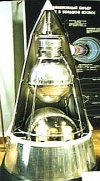


|
Sputnik
2
Sputnik II
Physical lab
PS 2
#00003
1957-002A
1957 Beta 1 |
 Sputnik
2 was the first spaceship which brought an animal in
space. The elliptical orbit had an apogee of 1770 km
and an apogee of 320 km. Sputnik II circulated the Earth
in 103,7 minutes. Sputnik
2 was the first spaceship which brought an animal in
space. The elliptical orbit had an apogee of 1770 km
and an apogee of 320 km. Sputnik II circulated the Earth
in 103,7 minutes.
Sputnik 2 was a three-part conical
satellite with a hight of 1.2m and was comprised of
the following sections:
- a cylindrical container
for scientific equipment
- a spherical container
for batteries, 2 transmitters and radiotelemetry systems
- a sealed cabin for the a dog named Laika
Laika
lived for one week and part of the downlink telemetry
was her heartbeat. She died on November 10th
1957 when oxygen in her capsule was exhausted.
Sputnik II transmitted for 7 days on the frequencies
20.005 MHz and 40.010 MHz.
Sputnik 2 decayed on
April 14th 1958. This recording
was provided by Alois DL3PD (SK).
|
Nov
3rd 1957 |
508
kg |
 Enclosed
is the recording of the heartbeat of the dog Laika aboard
Sputnik 2. The recording is from vinyl no. 2 which was
included in the Italian Enciclopaedia Luomo e lo spazio
(The man and the space) issued 1965 by Fratelli Fabbri.
Digitized and kindly provided by Federico Manzini. Enclosed
is the recording of the heartbeat of the dog Laika aboard
Sputnik 2. The recording is from vinyl no. 2 which was
included in the Italian Enciclopaedia Luomo e lo spazio
(The man and the space) issued 1965 by Fratelli Fabbri.
Digitized and kindly provided by Federico Manzini.
|
  In June
2010 I received from Dick W4PUJ (SK) In June
2010 I received from Dick W4PUJ (SK)
(ex WA4DGU)
together with a number of other unique audio recordings
enclosed recording of Sputnik II. Thanks Dick for providing
this recording. Dick became silent key on February 14th
2012.
|
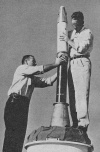
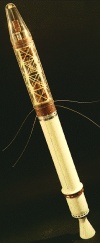

|
Explorer
1
Explorer I
1958 Alpha 1
#00004
1958-001A |
Explorer 1 was America's
first orbiting satellite. It was launched from Cape
Canaveral, Florida by an Army Jupiter C four stage rocket
into an elliptical orbit with an inclination of 33,3
degrees, a perigee of 320 km and an apogee of
2735 km. Explorer 1 circulated the Earth in 114,7 minutes.
The cylindrical satellite was 1.5m long and had
a diameter of 15cm. Explorer 1 featured 2 transmitters.
The transmitter on 108,03 MHz had a transmit power of
60 mW and operated 14 days, the transmitter on 108,0
MHz had a transmit power of 10 mW and transmitted until
May 23rd 1958. The transmissions
included information about the satellites temperature,
cosmic rays and micro-meteorites. In the second picture
to the left you can see a mesh of wires around the upper
part of the satellite. This was used to detect micro-meteorites.
Explorer 1 discovered the Van Allen radiation belt.
The batteries lasted about 3 months. Explorer
1 decayed on March 31st 1970. |
Jan
31st
1958 |
13,5
kg |
 This
recording of the countdown and launch of Explorer 1
is from vinyl no. 2 which was included in the Italian
Enciclopaedia Luomo e lo spazio (The man and the space)
issued 1965 by Fratelli Fabbri. Digitized and kindly
provided by Federico Manzini. This
recording of the countdown and launch of Explorer 1
is from vinyl no. 2 which was included in the Italian
Enciclopaedia Luomo e lo spazio (The man and the space)
issued 1965 by Fratelli Fabbri. Digitized and kindly
provided by Federico Manzini.
|
 This recording
was made by Roy W0SL in Dallas, Texas on February 11th,
1958 at 01:00 UTC using a home-made VHF converter in
front of a National NC-300 receiver. This recording
was kindly provided by Roy W0SL. This recording
was made by Roy W0SL in Dallas, Texas on February 11th,
1958 at 01:00 UTC using a home-made VHF converter in
front of a National NC-300 receiver. This recording
was kindly provided by Roy W0SL.
|
 Another
recording of Explorer I was kindly provided by Dick
W4PUJ (SK). Another
recording of Explorer I was kindly provided by Dick
W4PUJ (SK).
|
 This
recording of Explorer 1 is from vinyl no. 4 which was
included in the Italian Enciclopaedia Luomo e lo spazio
(The man and the space) issued 1965 by Fratelli Fabbri.
Digitized and kindly provided by Federico Manzini. This
recording of Explorer 1 is from vinyl no. 4 which was
included in the Italian Enciclopaedia Luomo e lo spazio
(The man and the space) issued 1965 by Fratelli Fabbri.
Digitized and kindly provided by Federico Manzini.
|
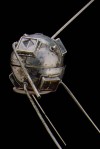
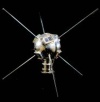
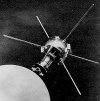
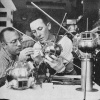
|
Vanguard
1
TV-4
1958 Beta 2
#00005
1958-002B |
 This
is the oldest man-made satellite which is still in orbit.
It is expected to last about another 190 years before
it finally decays. This spherical Navy test satellite
has a diameter of 16cm and was launched by a Vanguard
3-stage rocket into an elliptical orbit with an inclination
of 34,4 degrees, a perigee of 640 km and an apogee of
4020 km. The satellite had 2 power sources: the first
transmitter operated from a mercury cell supply and
had a life time of 3 weeks. Thanks to the fact that
this satellite was the first using solar cells the second
transmitter operated 6 years and 3 months. On February
21st 1965 it was declared to
be no more recognizable as the signal strength had declined
almost to zero. The output power of the transmitters
was 100mW (on 108.0 MHz) and 50mW (on 108.3 MHz) respectively.
The antenna system was comprised of 6 whip elements
each 30cm long. They made one turnstile antenna and
a dipole. The telemetry transmitted was the package
temperature indicated by the difference between the
two transmitter frequencies. Therefore, the recordings
were made with the receiver Beat Frequency Oscillator
(BFO) turned on in order to produce an audible tone
heard in the recordings. Thanks for the audio-file to
Roy W0SL. This
is the oldest man-made satellite which is still in orbit.
It is expected to last about another 190 years before
it finally decays. This spherical Navy test satellite
has a diameter of 16cm and was launched by a Vanguard
3-stage rocket into an elliptical orbit with an inclination
of 34,4 degrees, a perigee of 640 km and an apogee of
4020 km. The satellite had 2 power sources: the first
transmitter operated from a mercury cell supply and
had a life time of 3 weeks. Thanks to the fact that
this satellite was the first using solar cells the second
transmitter operated 6 years and 3 months. On February
21st 1965 it was declared to
be no more recognizable as the signal strength had declined
almost to zero. The output power of the transmitters
was 100mW (on 108.0 MHz) and 50mW (on 108.3 MHz) respectively.
The antenna system was comprised of 6 whip elements
each 30cm long. They made one turnstile antenna and
a dipole. The telemetry transmitted was the package
temperature indicated by the difference between the
two transmitter frequencies. Therefore, the recordings
were made with the receiver Beat Frequency Oscillator
(BFO) turned on in order to produce an audible tone
heard in the recordings. Thanks for the audio-file to
Roy W0SL.
|
Mar
17th
1958 |
1.5
kg |
 This
recording of the countdown and launch of Vanguard 1
is from vinyl no. 2 which was included in the Italian
Enciclopaedia Luomo e lo spazio (The man and the space)
issued 1965 by Fratelli Fabbri. Digitized and kindly
provided by Federico Manzini. This
recording of the countdown and launch of Vanguard 1
is from vinyl no. 2 which was included in the Italian
Enciclopaedia Luomo e lo spazio (The man and the space)
issued 1965 by Fratelli Fabbri. Digitized and kindly
provided by Federico Manzini.
|
 This
recording of Vanguard 1 while it was in its 7th
orbit. It is from vinyl no. 3 which was included in
the Italian Enciclopaedia Luomo e lo spazio (The man
and the space) issued 1965 by Fratelli Fabbri. Digitized
and kindly provided by Federico Manzini. This
recording of Vanguard 1 while it was in its 7th
orbit. It is from vinyl no. 3 which was included in
the Italian Enciclopaedia Luomo e lo spazio (The man
and the space) issued 1965 by Fratelli Fabbri. Digitized
and kindly provided by Federico Manzini.
|
 This recording
of Vanguard I was done while it was battery powered
and kindly provided by Dick W4PUJ (SK). This recording
of Vanguard I was done while it was battery powered
and kindly provided by Dick W4PUJ (SK).
|
 This recording
of Vanguard I was done while it was solar powered and
kindly provided by Dick W4PUJ (SK). This recording
of Vanguard I was done while it was solar powered and
kindly provided by Dick W4PUJ (SK).
|
 This recording
of Vanguard I was done after it was already 3 months
in operation and kindly provided by Dick W4PUJ (SK). This recording
of Vanguard I was done after it was already 3 months
in operation and kindly provided by Dick W4PUJ (SK).
|
 Vanguard
1 transmitted until February 21st
1965. This recording of Vanguard I was done after it
was already 1 year in operation and kindly provided
by Dick W4PUJ (SK). Vanguard
1 transmitted until February 21st
1965. This recording of Vanguard I was done after it
was already 1 year in operation and kindly provided
by Dick W4PUJ (SK).
|
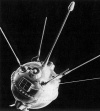
|
Lunik
I
Luna 1
Mechta
#00112
1959-012A |
Luna 1 was the first
of a series of Soviet automatic interplanetary stations
successfully launched in the direction of the Moon.
It actually landed on the Moon.
|
Jan
2nd 1959 |
361
kg |
 This recording
of a Lunik probe was kindly provided by Dick W4PUJ (SK).
It is possibly from Lunik I but we are not sure. It
could be also based on transmissions of Lunik II or
Lunik III. This recording
of a Lunik probe was kindly provided by Dick W4PUJ (SK).
It is possibly from Lunik I but we are not sure. It
could be also based on transmissions of Lunik II or
Lunik III.
|

|
Vostok-3 No.1
Sputnik
9
Korabl Sputnik 4
#00091
1961-008A |
 This
Space Ship Vostok-3 No.1 carried a dog named Chernuska
in space. Besides Chernuska also onboard was a dummy
cosmonaut, mice and a guinea pig. The flight lasted
for a single orbit, and a successful recovery was made.
Recording provided by Alois DL3PD (SK). This
Space Ship Vostok-3 No.1 carried a dog named Chernuska
in space. Besides Chernuska also onboard was a dummy
cosmonaut, mice and a guinea pig. The flight lasted
for a single orbit, and a successful recovery was made.
Recording provided by Alois DL3PD (SK).
|
Mar 9th
1961 |
4700 kg |
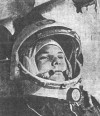

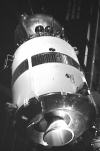
|
Russian
Spaceship
Vostok 1
#00103
1961-012A
(crew: Jurij Gagarin) |
 The first
man in space: Jurij Gagarin. He circulated the Earth
in his Russian Spaceship Vostok 1 during his flight
which had a duration of 108 minutes. Recording provided
by Alois DL3PD (SK). The first
man in space: Jurij Gagarin. He circulated the Earth
in his Russian Spaceship Vostok 1 during his flight
which had a duration of 108 minutes. Recording provided
by Alois DL3PD (SK).
|
Apr
12th
1961 |
4725
kg |
 Vinyl
single made in USSR Vinyl
single made in USSR
"12-IV 1961 CCCP Gagarin"
side 1 with Russian comments. Recording provided by
Maik Hermenau.
|
 Vinyl
single made in USSR Vinyl
single made in USSR
"12-IV 1961 CCCP Gagarin"
side 2 with German comments. Recording provided by Maik
Hermenau.
|
 Colorvox
"Schallbildkarte" Colorvox
"Schallbildkarte"
"Reportage über
den Weltraumflug Juri Gagarins". Recording provided
by Maik Hermenau.
|
 Report
in German language about the phase between the first
artificial satellite Sputnik 1 and the first man in
space Juri Gagarin. From a Schallfolie "Der Weg
in den Kosmos" which was provided in the 60s by
a Eastern German magazine called "Frösi".
Recording provided by Maik Hermenau. Report
in German language about the phase between the first
artificial satellite Sputnik 1 and the first man in
space Juri Gagarin. From a Schallfolie "Der Weg
in den Kosmos" which was provided in the 60s by
a Eastern German magazine called "Frösi".
Recording provided by Maik Hermenau.
|
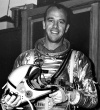
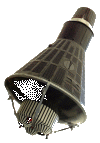
|
US
Spaceship
Freedom 7
MR-3
MERCR3
(crew: Alan B. Shepard Jr.) |
 Alan B.
Shepard Jr. (1924-1998) was the first American in space.
His flight in a Mercury capsule on top of a Redstone-MRLV
rocket had a duration of 15 minutes and 28 seconds.
As this was a ballistic suborbital flight reaching an
altitude of 187 km it did not get a International nor
a NORAD designator. His recovery at sea was viewed on
live TV. 10 years later Al Shepard was the commander
of Apollo 14 and landed on the Moon. Alan B.
Shepard Jr. (1924-1998) was the first American in space.
His flight in a Mercury capsule on top of a Redstone-MRLV
rocket had a duration of 15 minutes and 28 seconds.
As this was a ballistic suborbital flight reaching an
altitude of 187 km it did not get a International nor
a NORAD designator. His recovery at sea was viewed on
live TV. 10 years later Al Shepard was the commander
of Apollo 14 and landed on the Moon.
|
May
5th 1961 |
955
kg |
  These
recording are from vinyls no. 24 and no. 25 which were
included in the Italian Enciclopaedia Luomo e lo spazio
(The man and the space) issued 1965 by Fratelli Fabbri.
They include sequences of the launch campaign as well
as Shepard's voice while he was in orbit ("What
a beautiful view ..."). Digitized and kindly provided
by Federico Manzini. These
recording are from vinyls no. 24 and no. 25 which were
included in the Italian Enciclopaedia Luomo e lo spazio
(The man and the space) issued 1965 by Fratelli Fabbri.
They include sequences of the launch campaign as well
as Shepard's voice while he was in orbit ("What
a beautiful view ..."). Digitized and kindly provided
by Federico Manzini.
|
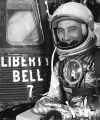
|
Liberty
Bell 7
MR-4
MERCR4
(crew: Virgil Ivan
"Gus" Grissom) |
Virgil Ivan "Gus"
Grissom (1926-1967) was the second American in space.
His flight in a Mercury Redstone 4 (MR-4) had a duration
of 15 minutes and 37 seconds. The main configuration
differences from the MR-3 spacecraft was the addition
of a large viewing window and an explosively actuated
side hatch (which actually failed during landing). As
this was a ballistic suborbital flight reaching an altitude
of 187 km it did not get a International nor a NORAD
designator. |
July
21st 1961 |
955
kg |
 This recording
is from vinyl no. 27 which was included in the Italian
Enciclopaedia Luomo e lo spazio (The man and the space)
issued 1965 by Fratelli Fabbri. They include sequences
of the launch campaign as well as Shepard's voice while
he was in orbit ("What a beautiful view ...").
Digitized and kindly provided by Federico Manzini. This recording
is from vinyl no. 27 which was included in the Italian
Enciclopaedia Luomo e lo spazio (The man and the space)
issued 1965 by Fratelli Fabbri. They include sequences
of the launch campaign as well as Shepard's voice while
he was in orbit ("What a beautiful view ...").
Digitized and kindly provided by Federico Manzini.
|
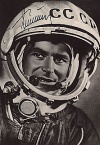
|
Russian
Spaceship
Vostok 2
Sputnik 12
#00168
1961-019A
(crew: Gherman S. Titov) |
 Russian
Spaceship Vostok 2 (3KA-4) with cosmonaut Gherman S.
Titov was launched by a Vostok rocket from Baikonur
(U.S.S.R.) into an 166x232 km orbit with 65° inclination.
The flight lasted 1 day and 1 hour during with G.S.
Titov circulated the earth 17 times. Russian
Spaceship Vostok 2 (3KA-4) with cosmonaut Gherman S.
Titov was launched by a Vostok rocket from Baikonur
(U.S.S.R.) into an 166x232 km orbit with 65° inclination.
The flight lasted 1 day and 1 hour during with G.S.
Titov circulated the earth 17 times.
|
Aug
6th 1961 |
4731
kg |
 This recording
is from vinyl no. 28 which was included in the Italian
Enciclopaedia Luomo e lo spazio (The man and the space)
issued 1965 by Fratelli Fabbri. It includes multiple
recordings of Titov's voice while he was in orbit. Digitized
and kindly provided by Federico Manzini. This recording
is from vinyl no. 28 which was included in the Italian
Enciclopaedia Luomo e lo spazio (The man and the space)
issued 1965 by Fratelli Fabbri. It includes multiple
recordings of Titov's voice while he was in orbit. Digitized
and kindly provided by Federico Manzini.
|
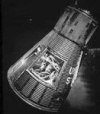
|
US
Spaceship
Friendship 7
Mercury Atlas 6
#00240
1962-003A
(crew: John Glenn) |
 Report
in German language about the first US astronaut John
Glenn circulating the Earth. During his flight in MA
6 (Mercury Atlas 6) he circulated the Earth 3 times.
Heftbeilage der Hauszeitschrift "Die Brücke"
Nr.2 vom Oktober 1962 der Pharmazeutischen Medizinischen
Abteilung der Farbwerke Hoechst AG. Recording provided
by Maik Hermenau. Report
in German language about the first US astronaut John
Glenn circulating the Earth. During his flight in MA
6 (Mercury Atlas 6) he circulated the Earth 3 times.
Heftbeilage der Hauszeitschrift "Die Brücke"
Nr.2 vom Oktober 1962 der Pharmazeutischen Medizinischen
Abteilung der Farbwerke Hoechst AG. Recording provided
by Maik Hermenau.
|
Feb
20th
1962 |
1900
kg |
 The voice
of John Glenn "Roger, zero G and I feel fine, capsule
is turning around". Recording courtesy of NASA. The voice
of John Glenn "Roger, zero G and I feel fine, capsule
is turning around". Recording courtesy of NASA.
|
 The voice
of John Glenn "We got speed - John Glenn".
Recording courtesy of NASA. The voice
of John Glenn "We got speed - John Glenn".
Recording courtesy of NASA.
|
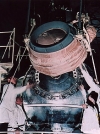
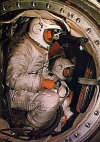

|
Voskhod-2
1965-022A
#01274
(crew: Pawel Iwanowitsch Beljajew, Alexej Archipowitsch
Leonow ) |
Voskhod
2, which carried two men into space, was equipped with
an extendable air lock that permitted Leonov's exit
into space without having to evacuate the main cabin
air. It was the first flight with an extra vehicular
activity (EVA) and cosmonaut Alexej Archipowitsch Leonow
was the first man who left a spacecraft and operated
in free space. The other crew member was commander Pawel
Iwanowitsch Beljajew. The flight of Voskhod 2 lasted
for 26 hours and 16 orbits were completed. A manually
controlled reentry was performed because of a malfunction
of the automatic orientation devices for the retrofire.
The spacecraft landed in a pine forest far north of
the target area. After locating the spacecraft, one
day was required to cut through the forest and bring
the crew out on skis.  Overall
the mission was a success. After Leonow retired he started
to create paintings of his experience in space. Enclosed
is a painting of his EVA. Overall
the mission was a success. After Leonow retired he started
to create paintings of his experience in space. Enclosed
is a painting of his EVA.
Voskhod-2
transmitted voice on 143.625 MHz, 18.035 MHz and 17.365
MHz and had a beacon transmitter on 19.996 MHz. The
143.625 MHz FM transmissions were used for line-of-sight
communications with ground stations while the short-wave
frequencies were used to communicate with the spacecraft
when it was far from Soviet territory. |
March 18th 1965 |
5682 kg |
 Enclosed
audio file is from a report about the Voskhod-2 focusing
on the EVA of Alexej Leonow. Supposedly the radio traffic
in the report was recorded during Leonows EVA. Enclosed
audio file is from a report about the Voskhod-2 focusing
on the EVA of Alexej Leonow. Supposedly the radio traffic
in the report was recorded during Leonows EVA.
|


|
Apollo 8
first
manned mission to fly and orbit the Moon
(crew:
William Anders, James Lovell, Frank Borman)
CSM-103
#03626
1968-118A |
 Originally Apollo
8 wasn't going to the Moon but was supposed to have
a low-earth orbit to test the Lunar Module and Command
Module. However, since the Lunar Module wasn't ready,
NASA decided to change the mission objectives and send
Apollo 8 to orbit the Moon 10 times. The crew William
Anders, James Lovell and Frank Borman was retrained
in record time for a completely new mission. They were
the first three humans to see the dark side of the Moon
and their voyage was the first ever to escape Earth's
gravitational force and visit another celestial body.
On Christmas Eve 1968, when approaching lunar
sunrise, the 3 crew members sent a famous broadcast
message back to Earth when taking turns reading the
first 10 verses from the book of Genesis. Audio courtesy
of NASA (3MB). Originally Apollo
8 wasn't going to the Moon but was supposed to have
a low-earth orbit to test the Lunar Module and Command
Module. However, since the Lunar Module wasn't ready,
NASA decided to change the mission objectives and send
Apollo 8 to orbit the Moon 10 times. The crew William
Anders, James Lovell and Frank Borman was retrained
in record time for a completely new mission. They were
the first three humans to see the dark side of the Moon
and their voyage was the first ever to escape Earth's
gravitational force and visit another celestial body.
On Christmas Eve 1968, when approaching lunar
sunrise, the 3 crew members sent a famous broadcast
message back to Earth when taking turns reading the
first 10 verses from the book of Genesis. Audio courtesy
of NASA (3MB).
|
Dec 21st
1968 |
28817 kg |

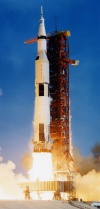
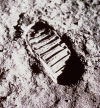
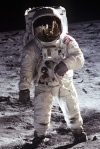
|
Apollo
11
first manned mission to land on the moon
(crew: Neil. A. Armstrong, Edwin E. Aldrin, Michael
Collins)
Command & Service Module
CSM-107
#04039
1969-059A
Lunar Module
LM/EASEP
#04041
1969-059C |
Apollo 11 was the first
manned mission to land on the moon. The LM (landing
module) spacecraft transmitted at S-band with a carrier
frequency of 2282.5 MHz both live television (FM modulated)
as well as telemetry (on PM modulated sub-carriers).
This communication system was collectively referred
to as the Unified S-Band Communication System.  Alan
Bean, who travelled to the moon aboard Apollo 12 and
was the 4th man on the moon,
painted pictures of Neil Armstrong and Buzz Aldrin.
Reprints are still available. You can find a picture
if you click on the icon to the right. Alan
Bean, who travelled to the moon aboard Apollo 12 and
was the 4th man on the moon,
painted pictures of Neil Armstrong and Buzz Aldrin.
Reprints are still available. You can find a picture
if you click on the icon to the right. |
Jul
16th
1969 |
28801
kg |
 The audio
file enclosed documents the successful launch sequence.
Recorded on July 16th 1969. The audio
file enclosed documents the successful launch sequence.
Recorded on July 16th 1969.
|
 The famous
words of Neil Armstrong, the first man on the Moon,
when he stepped on the moon. Recorded on July 20th 1969. The famous
words of Neil Armstrong, the first man on the Moon,
when he stepped on the moon. Recorded on July 20th 1969.
|
The second
man to step on the moon was Edwin E. Aldrin.  This
video shows him climbing down the ladder. This video
was received by Parkes Observatory in Australia. Video
courtesy of NASA. This
video shows him climbing down the ladder. This video
was received by Parkes Observatory in Australia. Video
courtesy of NASA. |
President
Nixon  talks
with the Astronauts and wished for ".. peace and
tranquility on the Earth." This video was received
by Parkes Observatory in Australia. Video courtesy of
NASA. talks
with the Astronauts and wished for ".. peace and
tranquility on the Earth." This video was received
by Parkes Observatory in Australia. Video courtesy of
NASA. |
 Vinyl
single "First man on the moon" side 1 includes
the speech of J.F.Kennedy announcing the plan to go
to the moon. Record provided by Maik Hermenau. Vinyl
single "First man on the moon" side 1 includes
the speech of J.F.Kennedy announcing the plan to go
to the moon. Record provided by Maik Hermenau.
|
 Vinyl
single "First man on the moon" side 2 includes
the launch of Apollo 11 and landing of Eagle. Record
provided by Maik Hermenau. Vinyl
single "First man on the moon" side 2 includes
the launch of Apollo 11 and landing of Eagle. Record
provided by Maik Hermenau.
|
 Part
1 of a report in German language about the first manned
mission to the moon, Vinyl LP "Original Dokumente
vom Weg zum Mond" war 1970 eine Beilageder Zeitschrift
"Bunte Illustrierte". Record provided by Maik
Hermenau (11 minutes). Part
1 of a report in German language about the first manned
mission to the moon, Vinyl LP "Original Dokumente
vom Weg zum Mond" war 1970 eine Beilageder Zeitschrift
"Bunte Illustrierte". Record provided by Maik
Hermenau (11 minutes).
|
 Part
2 of a report in German language about the first manned
mission to the moon, Vinyl LP "Original Dokumente
vom Weg zum Mond" war 1970 eine Beilageder Zeitschrift
"Bunte Illustrierte". Record provided by Maik
Hermenau (15 minutes). Part
2 of a report in German language about the first manned
mission to the moon, Vinyl LP "Original Dokumente
vom Weg zum Mond" war 1970 eine Beilageder Zeitschrift
"Bunte Illustrierte". Record provided by Maik
Hermenau (15 minutes).
|
 On July
21th 1969 03:51 UTC Larry Bassinger,
a ham radio amateur with the callsign W4EJA living in
Louisville, Kentucky, USA made a remarkable accomplishment: On July
21th 1969 03:51 UTC Larry Bassinger,
a ham radio amateur with the callsign W4EJA living in
Louisville, Kentucky, USA made a remarkable accomplishment:

He was able
to receive the VHF radio transmission from astronauts
Armstrong and Aldrin directly while they were walking
on the moon. Larry used modified surplus radio equipment
and a home-brew corner reflector antenna built with
chicken wire. He received the 259.7 MHz AM transmitter
in the backpack of Armstrong which he used to communicate
with the Lunar Module. In enclosed recording one can
hear the voice of Armstrong and also that of Aldrin
because the backpack of Armstrong received also the
voice of Aldrin on 279.0 MHz in FM and retransmitted
it also to the LM. Recording kindly provided by Larry
Baysinger.
|

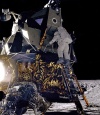

|
Apollo
12
(crew: Charles "Pete" Conrad,
Richard "Dick" F. Gordon, Alan L. "Al"
Bean)
CSM-108
#04225
1969-099A |
 This was
the 2nd mission of Apollo with
a landing on the moon. The rocket was struck twice (36
seconds and 52 seconds after launch) by a lightning.
You can hear the launch campaign including the conversation
about the lightning strikes in the first audio recording. This was
the 2nd mission of Apollo with
a landing on the moon. The rocket was struck twice (36
seconds and 52 seconds after launch) by a lightning.
You can hear the launch campaign including the conversation
about the lightning strikes in the first audio recording.
 The second
audio files documents communication between LM (the
lunar module with the nickname "Intrepid")
and Houston ground control during the final descent
phase (last 3 minutes) and the touch down on the moon
(110 h, 32 min and 36 sec mission elapsed time). The second
audio files documents communication between LM (the
lunar module with the nickname "Intrepid")
and Houston ground control during the final descent
phase (last 3 minutes) and the touch down on the moon
(110 h, 32 min and 36 sec mission elapsed time).
The crew returned safely on November 24th
1969.
I extracted the recordings from the NASA audio
collection.
 Alan
L. Bean was the 4th man on
the moon. After he left NASA he became an artist and
started painting beautiful scenes of the moon. Enclosed
a picture of himself which he named "A New Frontier". Alan
L. Bean was the 4th man on
the moon. After he left NASA he became an artist and
started painting beautiful scenes of the moon. Enclosed
a picture of himself which he named "A New Frontier".
|
Nov 14th 1969 |
28790 kg |


|
Apollo
13
aborted third manned mission to the moon
(crew: James A. Lovell, Jr., John L. Swigert, Jr., Fred
W. Haise, Jr. )
CSM-109
#04371
1970-029A |
This aborted 3rd
manned mission to moon  ended
almost fatal. Due to an explosion of the oxygen tank
in the service module the mission had to be aborted
and luckily the crew returned safely on April 17th
1970. See here a short movie of the damaged service
module when clicking on the picture to the right. ended
almost fatal. Due to an explosion of the oxygen tank
in the service module the mission had to be aborted
and luckily the crew returned safely on April 17th
1970. See here a short movie of the damaged service
module when clicking on the picture to the right. |
Apr 11th 1970 |
136077 kg |
 Listen
to the famous words of J. Swigert after the explosion
of the tank: "Houston, we've had a problem here." Listen
to the famous words of J. Swigert after the explosion
of the tank: "Houston, we've had a problem here."
|
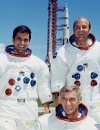
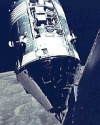

|
Apollo
17
last manned mission to the moon (crew: Eugene
A. Cernan, Harrison H. Schmitt, Ronald E. Evans)
CSM-114
#06300
1972-096A |
Apollo 17 was the 6th
and last Apollo mission during which humans walked on
the lunar surface. On December 11th
1972 commander Cernan and lunar module (LM) pilot Schmitt
landed in the Taurus-Littrow region of the Moon. The
Command and Service Module (CSM) with its pilot Evans
continued in its lunar orbit. During their stay on the
Moon, the astronauts set up scientific experiments,
took photographs, drove around with the rover and collected
lunar samples. The LM took off from the Moon on December
14th and the astronauts returned
to Earth on December 19th.
|
Dec 7th
1972 |
30320 kg |
 Enclosed
shortwave broadcast transmission of the launch of Apollo
17 by Voice of America (VOA) was recorded on Dec 7th
1972 by Ian Holder. It was kindly provided by Thomas
K4SWL from "The Shortwave Radio Audio Archive". Enclosed
shortwave broadcast transmission of the launch of Apollo
17 by Voice of America (VOA) was recorded on Dec 7th
1972 by Ian Holder. It was kindly provided by Thomas
K4SWL from "The Shortwave Radio Audio Archive".
|
 Enclosed
voice transmission of Apollo-17 while in earth orbit
was received on 296.8 MHz on December 7th
1972 at 07:08 UTC by R.S. (Dick) Flagg and Sven Grahn
in Titusville, Florida. Enclosed
voice transmission of Apollo-17 while in earth orbit
was received on 296.8 MHz on December 7th
1972 at 07:08 UTC by R.S. (Dick) Flagg and Sven Grahn
in Titusville, Florida.
This recording was kindly
provided by Sven Grahn with permission of R.S. (Dick)
Flagg.
|
 Enclosed
voice transmission of Apollo-17 while in lunar
orbit was received on 2287.5 MHz on December 12th
1972 by R.S. (Dick) Flagg and Sven Grahn in Biven's
Arm, Gainesville, Florida. Enclosed
voice transmission of Apollo-17 while in lunar
orbit was received on 2287.5 MHz on December 12th
1972 by R.S. (Dick) Flagg and Sven Grahn in Biven's
Arm, Gainesville, Florida.
This recording was kindly
provided by Sven Grahn with permission of R.S. (Dick)
Flagg.
|
 This recording
of the Apollo 17 descent and lunar landing was made
at Honeysuckle Creek and was preserved by Alan Foster.
Goldstone was tracking, and so this was recorded from
the Net 1 feed. It begins as Challenger is at 57,000
feet. Touchdown is 10'40" into the recording. The
audio quality on this recording is quite good. Ron Evans
in the orbiting Command Module is not heard on this
circuit from Goldstone, whereas the Cernan and Schmitt
and Houston can hear him. Digitized from the original
tapes and kindly provided by Colin Mackellar. This recording
of the Apollo 17 descent and lunar landing was made
at Honeysuckle Creek and was preserved by Alan Foster.
Goldstone was tracking, and so this was recorded from
the Net 1 feed. It begins as Challenger is at 57,000
feet. Touchdown is 10'40" into the recording. The
audio quality on this recording is quite good. Ron Evans
in the orbiting Command Module is not heard on this
circuit from Goldstone, whereas the Cernan and Schmitt
and Houston can hear him. Digitized from the original
tapes and kindly provided by Colin Mackellar.
|
 Enclosed
recording of the audio link between the team on the
moon while driving around with the rover and the ground
staff on Earth was recorded on December 13th
1972 around 05:00 UTC by Bob K5DZE (ex DA1EZ). It was
actually a live re-transmission on 7.524 MHz in SSB
between 2 NASA stations. You can hear in this excellent
20 minutes long recording the slow but strong fading
of the signal coming from the moon. Many thanks to Bob
K5DZE for kindly providing this interesting recording. Enclosed
recording of the audio link between the team on the
moon while driving around with the rover and the ground
staff on Earth was recorded on December 13th
1972 around 05:00 UTC by Bob K5DZE (ex DA1EZ). It was
actually a live re-transmission on 7.524 MHz in SSB
between 2 NASA stations. You can hear in this excellent
20 minutes long recording the slow but strong fading
of the signal coming from the moon. Many thanks to Bob
K5DZE for kindly providing this interesting recording.
|
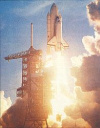
|
STS-1
Columbia
#12399
1981-034A |
 German
report about the first launch of a space shuttle: STS-1
Columbia which was broadcasted by Bayrischer Rundfunk.
Record provided by Maik Hermenau. German
report about the first launch of a space shuttle: STS-1
Columbia which was broadcasted by Bayrischer Rundfunk.
Record provided by Maik Hermenau.
You can find many
more recordings from Spaceships like he Space Shuttle
in the respective section of this website.
|
Apr 12th 1981 |
4908 kg |
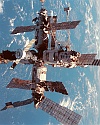
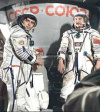
|
MIR
Space Station
#16609
1986-017A |
Mir (english peace),
a Russian space station, was the world's first consistently
inhabited long-term research station in space. 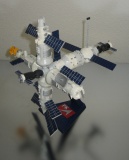 Constructed
from 1986 to 1996 using a modular design (core
module launched February 20th 1986) the station was
in operation for fifteen years before it was deliberately
de-orbited and re-entered into the atmosphere over the
South Pacific Ocean on March 23rd 2001. 10 years after
its reentry I built a model of MIR which is now in my
bookshelf and a nice reminiscence of the various contacts
I had with people onboard MIR. Constructed
from 1986 to 1996 using a modular design (core
module launched February 20th 1986) the station was
in operation for fifteen years before it was deliberately
de-orbited and re-entered into the atmosphere over the
South Pacific Ocean on March 23rd 2001. 10 years after
its reentry I built a model of MIR which is now in my
bookshelf and a nice reminiscence of the various contacts
I had with people onboard MIR. |
Feb
20th
1986 (core module) |
140000
kg |
The first crew to visit
MIR were Leonid Kizim and Vladimir Soloviev. Their Soyuz
T-15 spacecraft was launched on March 13th
1986 and they docked to MIR on March 14th.
They stayed in space for 125 days and during that time
even travelled from MIR to Salyut 6 and back before
finally returning back to earth.
 The first
audio file was recorded by Sven Grahn on March 15th 1986 15:27
UTC on 121.75 MHz, apparently shortly after they entered
MIR. Many thanks to Sven Grahn. The first
audio file was recorded by Sven Grahn on March 15th 1986 15:27
UTC on 121.75 MHz, apparently shortly after they entered
MIR. Many thanks to Sven Grahn.
 The second
audio file was recorded the day after on March 16th 1986 14:14
UTC on 143.625 MHz also by Sven Grahn. The second
audio file was recorded the day after on March 16th 1986 14:14
UTC on 143.625 MHz also by Sven Grahn. |


|
International Space
Station ISS
#25544
1998-067A |
The first crew of the
ISS was the team of Commander William M. Shepherd, Soyuz
Pilot Yuri P. Gidzenko and Flight Engineer Sergei Krikalev.
They arrived with a Soyuz spacecraft on Nov. 2nd 2000 and stayed
136 days.
 In the
sound file enclosed Bill Shepherd is thanking the ground
crews. Recorded shortly after arrival of the 1st
crew on Nov. 2nd
2000 at 12:27 UTC on 143.625 MHz by Sven Grahn. In the
sound file enclosed Bill Shepherd is thanking the ground
crews. Recorded shortly after arrival of the 1st
crew on Nov. 2nd
2000 at 12:27 UTC on 143.625 MHz by Sven Grahn.
You can find many more recordings from Spaceships like
ISS in the respective section of this website. |
Nov 20th
1998
(Zarja module) |
183283 kg |
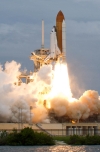
|
STS-135
Atlantis OV-104
#37736
2011-031A |
STS-135
was the final shutttle mission. It was launched in July
8th 2011 from Kennedy Space
Center and docked to ISS on July 10th
2011 at 15:07 UTC.  STS-135
Atlantis's External Tank video downlink was received
over Europe by Nils von Storch 24 minutes after launch
on 2272.5 MHz FM. Normally an internal timer disables
the 10 Watts s-band video transmitter onboard the External
Tank (ET) about 15 Minutes after launch, to avoid interference
with S-Band communication systems in Europe. On this
final Space Shuttle mission however, engineers decided
to disable the timer in order to capture video from
the ETs perspective when it re-entries the earths atmosphere
about 60 minutes after launch. Unfortunately the signal
was at 4° elevation only before disappearing behind
the horizon again, which is the reason why the received
video is only so short. Equipment used to receive this
video was a 90cm mesh dish with 3,5 turn RHCP Helix
for 2250 MHz, EME103B S-Band LNA and a G1MFG S-Band
video receiver. Thanks to Nils for sharing this video
with us. The mission lasted 13 days ending with a landing
at Cape Canaveral on July 21st
2011 at 09:55 UTC. Please note that the .mp4-video is
almost 20 MByte large. STS-135
Atlantis's External Tank video downlink was received
over Europe by Nils von Storch 24 minutes after launch
on 2272.5 MHz FM. Normally an internal timer disables
the 10 Watts s-band video transmitter onboard the External
Tank (ET) about 15 Minutes after launch, to avoid interference
with S-Band communication systems in Europe. On this
final Space Shuttle mission however, engineers decided
to disable the timer in order to capture video from
the ETs perspective when it re-entries the earths atmosphere
about 60 minutes after launch. Unfortunately the signal
was at 4° elevation only before disappearing behind
the horizon again, which is the reason why the received
video is only so short. Equipment used to receive this
video was a 90cm mesh dish with 3,5 turn RHCP Helix
for 2250 MHz, EME103B S-Band LNA and a G1MFG S-Band
video receiver. Thanks to Nils for sharing this video
with us. The mission lasted 13 days ending with a landing
at Cape Canaveral on July 21st
2011 at 09:55 UTC. Please note that the .mp4-video is
almost 20 MByte large. |
Jul 8th 2011 |
5000 kg |